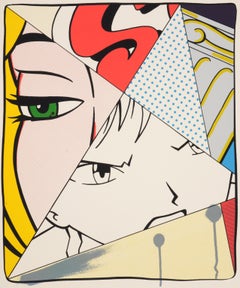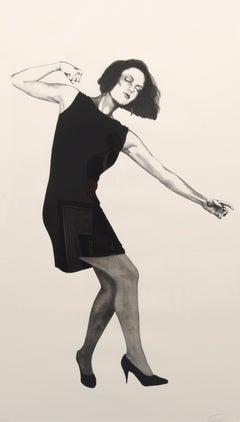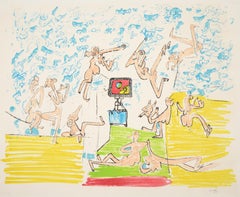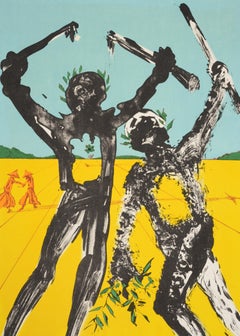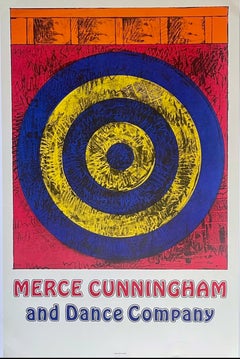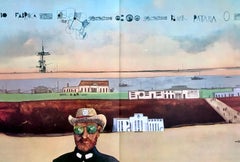Palm Beach Modern Gallery Figurative Prints
to
4
5
7
1
Overall Width
to
Overall Height
to
8
4
2
2
2
2
1
1
1
10
7
2
2
1
9
7
1
10
5
4
3
3
1
1
1
1
1
1
1
1
1
1
1
1
1
1
1
13
2
2
1
1
9
17
CRASH RED S Serigraph
By John Crash Matos
Located in Lake Worth Beach, FL
Artist/Designer; Manufacturer: CRASH aka John Matos (American, b. 1961)
Marking(s); notes: signed; ed. 24/35; 1990
Materials: serigraph
Dimensions (H, W, D): 22"h, 30"w (work is not ...
Category
1990s Pop Art Abstract Prints
Materials
Lithograph
Large Robert Longo TILLMAN Lithograph, 70"H (JAMES also available, priced each)
By Robert Longo
Located in Lake Worth Beach, FL
Artist/Designer; Manufacturer: Robert Longo (American, b. 1955)
Marking(s); notes: signed, blind stamp; ed. HC 1/10 aside from edition of 50; 2000
Materials: lithograph on Arches wov...
Category
Early 2000s Pop Art Figurative Prints
Materials
Lithograph
Mr. Brainwash GLITCH - PINK Screenprint, Signed Edition
By Mr. Brainwash
Located in Lake Worth Beach, FL
Artist/Designer; Manufacturer: Mr. Brainwash aka Thierry Guetta (French, b. 1966)
Marking(s); notes: signed, thumb print; 2018
Materials: screenprint on paper
Dimensions (H, W, D): 2...
Category
2010s Pop Art Figurative Prints
Materials
Lithograph
Mr. Brainwash GLITCH - BLUE Screenprint, Signed Edition
By Mr. Brainwash
Located in Lake Worth Beach, FL
Artist/Designer; Manufacturer: Mr. Brainwash aka Thierry Guetta (French, b. 1966)
Marking(s); notes: signed, thumb print; 2018
Materials: screenprint on paper
Dimensions (H, W, D): 2...
Category
2010s Pop Art Figurative Prints
Materials
Lithograph
Roberto Matta FOG GOG MAGOG PLANCHE 6 Lithograph
By Roberto Matta
Located in Lake Worth Beach, FL
Artist/Designer; Manufacturer: Roberto Matta (Chilean, 1911-2002)
Marking(s); notes: signed, blind stamp; ed. 94/100; 1971
Materials: lithograph on Arches paper
Dimensions (H, W, D):...
Category
1970s Surrealist Figurative Prints
Materials
Lithograph
Salvador Dali PEACE AT LAST! Lithograph
By Salvador Dalí
Located in Lake Worth Beach, FL
Artist/Designer; Manufacturer: Salvador Dali (Spanish, 1904-1989)
Marking(s); notes: signed, blind stamp; ed. LVIII/C; 1973
Materials: lithograph on Piera paper
Dimensions (H, W, D):...
Category
1970s Surrealist Figurative Prints
Materials
Lithograph
Hasui Kawase NIGHT FISHING AT ITAKO Woodcut Print
Located in Lake Worth Beach, FL
Artist/Designer; Manufacturer: Hasui Kawase (Japanese, 1883-1957)
Marking(s); notes: artist's seal; circa 1935
Materials: woodcut
Dimensions (H, W, D): 5.5"h, 3.5"w; 12.75"h, 9.75"w...
Category
20th Century Modern Landscape Prints
Materials
Woodcut
Peter Max JIMI HENDRIX Silkscreen
By Peter Max
Located in Lake Worth Beach, FL
Artist/Designer; Manufacturer: Peter Max (American, b. 1937)
Marking(s); notes: signed; ed. 37/45; 1997
Materials: silkscreen on Lenox museum board
Dimensions (H, W, D): 21"h, 27"w; ...
Category
20th Century Pop Art Figurative Prints
Materials
Screen
Alexander Calder UNTITLED Lithograph
By Alexander Calder
Located in Lake Worth Beach, FL
Artist/Designer; Manufacturer: Alexander Calder (American, 1898-1976)
Marking(s); notes: ed. 111/200; 1976
Materials: lithograph on BFK Rives paper
Dimensions (H, W, D): 15.75"h, 17....
Category
20th Century Modern Figurative Prints
Materials
Lithograph
Chuck Close KARA Felt-Stamp Oil & Screenprint
By Chuck Close
Located in Lake Worth Beach, FL
Artist/Designer; Manufacturer: Chuck Close (American, 1940-2021)
Marking(s); notes: signed; ed. 22/40; 2012
Materials: felt-stamp oil paint and screenprint in colors on Twinrocker ha...
Category
2010s Pop Art Portrait Prints
Materials
Lithograph, Oil
Keith Haring INTERNATIONAL VOLUNTEER DAY Lithograph, Signed Edition
By Keith Haring
Located in Lake Worth Beach, FL
Artist/Designer; Manufacturer: Keith Haring (American, 1958-1990)
Marking(s); notes: signed; ed. 280/1000; 1988
Materials: lithograph
Dimensions (H, W, D): 11.25"h, 8.5"w; 21.5"h, 17...
Category
1980s Pop Art Abstract Prints
Materials
Lithograph
Large Steven Klein “Mad Magic Magnificent” C-Print, 39.5"W
By Steven Klein
Located in Lake Worth Beach, FL
Designer & Manufacturer: Steven Klein (b. 1965)
Markings/Notes: signed, marking(s); ed. 1/5; 2004
Country of Origin & Materials: American; chromogenic print on aluminum
Dimensions...
Category
Early 2000s Contemporary Figurative Prints
Materials
C Print
Alice Neel MAN IN HARNESS Lithograph, Signed Edition
By Alice Neel
Located in Lake Worth Beach, FL
Artist/Designer; Manufacturer: Alice Neel (1900-1984)
Marking(s); notes: signed; ed. 23/100; 1980
Country of origin; materials: American; lithograph
Dimensions (H, W, D): 36.25"h, 27...
Category
1980s Contemporary Portrait Prints
Materials
Lithograph
Massimo Vitali MARINA DI MASSA Lithograph, 26"H x 34"W
By Massimo Vitali
Located in Lake Worth Beach, FL
Artist/Designer; Manufacturer: Massimo Vitali (Italian, b. 1944)
Marking(s); notes: artist's stamp verso; ed. 59/120; 2006
Materials: offset lithograph
Dimensions (H, W, D): 26.75"h,...
Category
Early 2000s Contemporary Figurative Prints
Materials
Lithograph, Offset
Massimo Vitali VIAREGGIO AIR SHOW Lithograph, 26"H x 34"W
By Massimo Vitali
Located in Lake Worth Beach, FL
Artist/Designer; Manufacturer: Massimo Vitali (Italian, b. 1944)
Marking(s); notes: artist's stamp verso; ed. 50/120; 2006
Materials: offset lithograph
Dimensions (H, W, D): 26.75"h,...
Category
Early 2000s Contemporary Figurative Prints
Materials
Lithograph, Offset
Andy Warhol (After) COWBOYS & INDIANS Prints, Priced Each
By Andy Warhol
Located in Lake Worth Beach, FL
Artist/Designer: Andy Warhol (after) (American, 1928-1987)
Marking(s); notes: copyright/publisher’s ink stamp, blind stamp; unknown edition size; 1986
Materials: screenprint in color...
Category
20th Century Pop Art Figurative Prints
Materials
Screen
Max Ernst LE RIRE DE POETES Lithograph
By Max Ernst
Located in Lake Worth Beach, FL
Artist/Designer; Manufacturer: Max Ernst (German, 1891-1976)
Marking(s); notes: signed, 473, 4635/2512, marking(s); ed. 44/50; 1969
Materials: lithograph
Dimensions (H, W, D): 10.75"...
Category
20th Century Dada Figurative Prints
Materials
Lithograph
Related Items
Target with Four Faces, 1968, Limited Edition offset lithograph Pop Art poster
By Jasper Johns
Located in New York, NY
Jasper Johns
Target with Four Faces, 1968
Offset lithograph poster for Merce Cunningham Dance Company
Limited Edition of 300 (unsigned and unnumbered)
35 × 23 inches
Printed by by U...
Category
1960s Pop Art Abstract Prints
Materials
Lithograph, Offset
Saul Steinberg lithograph 1970s (Saul Steinberg prints)
By Saul Steinberg
Located in NEW YORK, NY
Vintage Saul Steinberg Lithograph
Published by: Galerie Maeght, Paris, c.1970
Portfolio: Derrière le miroir
Excellent frame piece
Lithograph in colors
15 x 22 inches
Fold-line as i...
Category
1970s Pop Art Figurative Prints
Materials
Lithograph
Idols - Lithograph by Max Ernst - 1972
By Max Ernst
Located in Roma, IT
Idols is a lithograph on Arches paper realized by Max Ernst in 1972.
Belongs to the suite "Judith". Limited edition of 500.
Unsigned and unnumbered, as issued.
Godd conditions.
T...
Category
1970s Surrealist Figurative Prints
Materials
Lithograph
Vintage Jim Dine tool poster Kunsthalle Bern (Saw) neon blue 1970s retro font
By Jim Dine
Located in New York, NY
Original exhibition poster printed on the occasion of Jim Dine's 1971 exhibition at Kunsthalle Bern, featuring Saw, 1971. Against a sea of electric blue, Dine has written “saw” in lo...
Category
1970s Pop Art Figurative Prints
Materials
Paper, Offset
Paolozzi Signed 1969 poster Galerie Mikro vintage futuristic psychedelic pop art
By Eduardo Paolozzi
Located in New York, NY
Printed in chartreuse, dark green, bright yellow, orange, and brown, this surreal scene features a grey-walled room populated with strange machinery and a red chair. Paolozzi creates...
Category
1960s Pop Art Figurative Prints
Materials
Offset
Through the Window - Lithograph by Max Ernst - 1972
By Max Ernst
Located in Roma, IT
Through the Window is a lithograph on Arches paper realized by Max Ernst in 1972.
Belongs to the suite "Judith". Limited edition of 500.
Unsigned and unnumbered, as issued.
Godd c...
Category
1970s Surrealist Figurative Prints
Materials
Lithograph
$447
H 16.15 in W 11.42 in D 0.04 in
Marc Chagall - Inspiration - Original Lithograph from "Chagall Lithographe" v. 2
By Marc Chagall
Located in Collonge Bellerive, Geneve, CH
Marc Chagall
Original Lithograph from Chagall Lithographe 1957-1962. VOLUME II.
1963
Dimensions: 32 x 24 cm
From the unsigned edition of 10000 copies without margins
Reference: Mourlot 398
Condition : Excellent
Marc Chagall (born in 1887)
Marc Chagall was born in Belarus in 1887 and developed an early interest in art. After studying painting, in 1907 he left Russia for Paris, where he lived in an artist colony on the city’s outskirts. Fusing his own personal, dreamlike imagery with hints of the fauvism and cubism popular in France at the time, Chagall created his most lasting work—including I and the Village (1911)—some of which would be featured in the Salon des Indépendants exhibitions. After returning to Vitebsk for a visit in 1914, the outbreak of WWI trapped Chagall in Russia. He returned to France in 1923 but was forced to flee the country and Nazi persecution during WWII. Finding asylum in the U.S., Chagall became involved in set and costume design before returning to France in 1948. In his later years, he experimented with new art forms and was commissioned to produce numerous large-scale works. Chagall died in St.-Paul-de-Vence in 1985.
The Village
Marc Chagall was born in a small Hassidic community on the outskirts of Vitebsk, Belarus, on July 7, 1887. His father was a fishmonger, and his mother ran a small sundries shop in the village. As a child, Chagall attended the Jewish elementary school, where he studied Hebrew and the Bible, before later attending the Russian public school. He began to learn the fundamentals of drawing during this time, but perhaps more importantly, he absorbed the world around him, storing away the imagery and themes that would feature largely in most of his later work.
At age 19 Chagall enrolled at a private, all-Jewish art school and began his formal education in painting, studying briefly with portrait artist Yehuda Pen. However, he left the school after several months, moving to St. Petersburg in 1907 to study at the Imperial Society for the Protection of Fine Arts. The following year, he enrolled at the Svanseva School, studying with set designer Léon Bakst, whose work had been featured in Sergei Diaghilev's Ballets Russes. This early experience would prove important to Chagall’s later career as well.
Despite this formal instruction, and the widespread popularity of realism in Russia at the time, Chagall was already establishing his own personal style, which featured a more dreamlike unreality and the people, places and imagery that were close to his heart. Some examples from this period are his Window Vitebsk (1908) and My Fianceé with Black Gloves (1909), which pictured Bella Rosenfeld, to whom he had recently become engaged.
The Beehive
Despite his romance with Bella, in 1911 an allowance from Russian parliament member and art patron Maxim Binaver enabled Chagall to move to Paris, France. After settling briefly in the Montparnasse neighborhood, Chagall moved further afield to an artist colony known as La Ruche (“The Beehive”), where he began to work side by side with abstract painters such as Amedeo Modigliani and Fernand Léger as well as the avant-garde poet Guillaume Apollinaire. At their urging, and under the influence of the wildly popular fauvism and cubism, Chagall lightened his palette and pushed his style ever further from reality. I and the Village (1911) and Homage to Apollinaire (1912) are among his early Parisian works, widely considered to be his most successful and representative period.
Though his work stood stylistically apart from his cubist contemporaries, from 1912 to 1914 Chagall exhibited several paintings at the annual Salon des Indépendants exhibition, where works by the likes of Juan Gris, Marcel Duchamp and Robert Delaunay were causing a stir in the Paris art world. Chagall’s popularity began to spread beyond La Ruche, and in May 1914 he traveled to Berlin to help organize his first solo exhibition, at Der Sturm Gallery. Chagall remained in the city until the highly acclaimed show opened that June. He then returned to Vitebsk, unaware of the fateful events to come.
War, Peace and Revolution
In August 1914 the outbreak of World War I precluded Chagall’s plans to return to Paris. The conflict did little to stem the flow of his creative output, however, instead merely giving him direct access to the childhood scenes so essential to his work, as seen in paintings such as Jew in Green (1914) and Over Vitebsk (1914). His paintings from this period also occasionally featured images of the war’s impact on the region, as with Wounded Soldier (1914) and Marching (1915). But despite the hardships of life during wartime, this would also prove to be a joyful period for Chagall. In July 1915 he married Bella, and she gave birth to a daughter, Ida, the following year. Their appearance in works such as Birthday (1915), Bella and Ida by the Window (1917) and several of his “Lovers” paintings give a glimpse of the island of domestic bliss that was Chagall’s amidst the chaos.
To avoid military service and stay with his new family, Chagall took a position as a clerk in the Ministry of War Economy in St. Petersburg. While there he began work on his autobiography and also immersed himself in the local art scene, befriending novelist Boris Pasternak, among others. He also exhibited his work in the city and soon gained considerable recognition. That notoriety would prove important in the aftermath of the 1917 Russian Revolution when he was appointed as the Commissar of Fine Arts in Vitebsk. In his new post, Chagall undertook various projects in the region, including the 1919 founding of the Academy of the Arts. Despite these endeavors, differences among his colleagues eventually disillusioned Chagall. In 1920 he relinquished his position and moved his family to Moscow, the post-revolution capital of Russia.
In Moscow, Chagall was soon commissioned to create sets and costumes for various productions at the Moscow State Yiddish Theater...
Category
1960s Surrealist Figurative Prints
Materials
Lithograph
$1,486
H 9.45 in W 12.6 in D 0.04 in
Marc Chagall - The Candlestick - Original Lithograph
By Marc Chagall
Located in Collonge Bellerive, Geneve, CH
The Candlestick, from Jean Leymarie, Vitraux pour Jérusalem (Jerusalem Windows), André Sauret, Monte Carlo, 1962 (see M. 366-72; see C. books ...
Category
1960s Surrealist Figurative Prints
Materials
Lithograph
$2,507
H 12.8 in W 9.65 in D 0.04 in
Marc Chagall - The Red Rider - Original Lithograph
By Marc Chagall
Located in Collonge Bellerive, Geneve, CH
Marc Chagall - Original Lithograph
The Red Rider
From the unsigned, unnumbered lithograph printed in the literary review XXe Siecle
1957
See Mourlot 191
Dimensions: 32 x 24 cm
Publisher: G. di San Lazzaro.
Marc Chagall (born in 1887)
Marc Chagall was born in Belarus in 1887 and developed an early interest in art. After studying painting, in 1907 he left Russia for Paris, where he lived in an artist colony on the city’s outskirts. Fusing his own personal, dreamlike imagery with hints of the fauvism and cubism popular in France at the time, Chagall created his most lasting work—including I and the Village (1911)—some of which would be featured in the Salon des Indépendants exhibitions. After returning to Vitebsk for a visit in 1914, the outbreak of WWI trapped Chagall in Russia. He returned to France in 1923 but was forced to flee the country and Nazi persecution during WWII. Finding asylum in the U.S., Chagall became involved in set and costume design before returning to France in 1948. In his later years, he experimented with new art forms and was commissioned to produce numerous large-scale works. Chagall died in St.-Paul-de-Vence in 1985.
The Village
Marc Chagall was born in a small Hassidic community on the outskirts of Vitebsk, Belarus, on July 7, 1887. His father was a fishmonger, and his mother ran a small sundries shop in the village. As a child, Chagall attended the Jewish elementary school, where he studied Hebrew and the Bible, before later attending the Russian public school. He began to learn the fundamentals of drawing during this time, but perhaps more importantly, he absorbed the world around him, storing away the imagery and themes that would feature largely in most of his later work.
At age 19 Chagall enrolled at a private, all-Jewish art school and began his formal education in painting, studying briefly with portrait artist Yehuda Pen. However, he left the school after several months, moving to St. Petersburg in 1907 to study at the Imperial Society for the Protection of Fine Arts. The following year, he enrolled at the Svanseva School, studying with set designer Léon Bakst, whose work had been featured in Sergei Diaghilev's Ballets Russes. This early experience would prove important to Chagall’s later career as well.
Despite this formal instruction, and the widespread popularity of realism in Russia at the time, Chagall was already establishing his own personal style, which featured a more dreamlike unreality and the people, places and imagery that were close to his heart. Some examples from this period are his Window Vitebsk (1908) and My Fianceé with Black Gloves (1909), which pictured Bella Rosenfeld, to whom he had recently become engaged.
The Beehive
Despite his romance with Bella, in 1911 an allowance from Russian parliament member and art patron Maxim Binaver enabled Chagall to move to Paris, France. After settling briefly in the Montparnasse neighborhood, Chagall moved further afield to an artist colony known as La Ruche (“The Beehive”), where he began to work side by side with abstract painters such as Amedeo Modigliani and Fernand Léger as well as the avant-garde poet Guillaume Apollinaire. At their urging, and under the influence of the wildly popular fauvism and cubism, Chagall lightened his palette and pushed his style ever further from reality. I and the Village (1911) and Homage to Apollinaire (1912) are among his early Parisian works, widely considered to be his most successful and representative period.
Though his work stood stylistically apart from his cubist contemporaries, from 1912 to 1914 Chagall exhibited several paintings at the annual Salon des Indépendants exhibition, where works by the likes of Juan Gris, Marcel Duchamp and Robert Delaunay were causing a stir in the Paris art world. Chagall’s popularity began to spread beyond La Ruche, and in May 1914 he traveled to Berlin to help organize his first solo exhibition, at Der Sturm Gallery. Chagall remained in the city until the highly acclaimed show opened that June. He then returned to Vitebsk, unaware of the fateful events to come.
War, Peace and Revolution
In August 1914 the outbreak of World War I precluded Chagall’s plans to return to Paris. The conflict did little to stem the flow of his creative output, however, instead merely giving him direct access to the childhood scenes so essential to his work, as seen in paintings such as Jew in Green (1914) and Over Vitebsk (1914). His paintings from this period also occasionally featured images of the war’s impact on the region, as with Wounded Soldier (1914) and Marching (1915). But despite the hardships of life during wartime, this would also prove to be a joyful period for Chagall. In July 1915 he married Bella, and she gave birth to a daughter, Ida, the following year. Their appearance in works such as Birthday (1915), Bella and Ida by the Window (1917) and several of his “Lovers” paintings give a glimpse of the island of domestic bliss that was Chagall’s amidst the chaos.
To avoid military service and stay with his new family, Chagall took a position as a clerk in the Ministry of War Economy in St. Petersburg. While there he began work on his autobiography and also immersed himself in the local art scene, befriending novelist Boris Pasternak, among others. He also exhibited his work in the city and soon gained considerable recognition. That notoriety would prove important in the aftermath of the 1917 Russian Revolution when he was appointed as the Commissar of Fine Arts in Vitebsk. In his new post, Chagall undertook various projects in the region, including the 1919 founding of the Academy of the Arts. Despite these endeavors, differences among his colleagues eventually disillusioned Chagall. In 1920 he relinquished his position and moved his family to Moscow, the post-revolution capital of Russia.
In Moscow, Chagall was soon commissioned to create sets and costumes for various productions at the Moscow State Yiddish Theater, where he would paint a series of murals titled Introduction to the Jewish Theater as well. In 1921, Chagall also found work as a teacher at a school for war orphans. By 1922, however, Chagall found that his art had fallen out of favor, and seeking new horizons he left Russia for good.
Flight
After a brief stay in Berlin, where he unsuccessfully sought to recover the work exhibited at Der Sturm before the war, Chagall moved his family to Paris in September 1923. Shortly after their arrival, he was commissioned by art dealer and publisher Ambroise Vollard to produce a series of etchings for a new edition of Nikolai Gogol's 1842 novel Dead Souls. Two years later Chagall began work on an illustrated edition of Jean de la Fontaine’s Fables, and in 1930 he created etchings for an illustrated edition of the Old Testament, for which he traveled to Palestine to conduct research.
Chagall’s work during this period brought him new success as an artist and enabled him to travel throughout Europe in the 1930s. He also published his autobiography, My Life (1931), and in 1933 received a retrospective at the Kunsthalle in Basel, Switzerland. But at the same time that Chagall’s popularity was spreading, so, too, was the threat of Fascism and Nazism. Singled out during the cultural "cleansing" undertaken by the Nazis in Germany, Chagall’s work was ordered removed from museums throughout the country. Several pieces were subsequently burned, and others were featured in a 1937 exhibition of “degenerate art” held in Munich. Chagall’s angst regarding these troubling events and the persecution of Jews in general can be seen in his 1938 painting White Crucifixion.
With the eruption of World War II, Chagall and his family moved to the Loire region before moving farther south to Marseilles following the invasion of France. They found a more certain refuge when, in 1941, Chagall’s name was added by the director of the Museum of Modern Art (MOMA) in New York City to a list of artists and intellectuals deemed most at risk from the Nazis’ anti-Jewish campaign. Chagall and his family would be among the more than 2,000 who received visas and escaped this way.
Haunted Harbors
Arriving in New York City in June 1941, Chagall discovered that he was already a well-known artist there and, despite a language barrier, soon became a part of the exiled European artist community. The following year he was commissioned by choreographer Léonide Massine to design sets and costumes for the ballet Aleko, based on Alexander Pushkin’s “The Gypsies” and set to the music of Pyotr Ilyich Tchaikovsky.
But even as he settled into the safety of his temporary home, Chagall’s thoughts were frequently consumed by the fate befalling the Jews of Europe and the destruction of Russia, as paintings such as The Yellow Crucifixion...
Category
1950s Surrealist Figurative Prints
Materials
Lithograph
$2,925
H 12.6 in W 9.45 in D 0.04 in
Jim Dine Red Design for Satin Heart "The Picture of Dorian Grey" bleeding heart
By Jim Dine
Located in New York, NY
This proof depicts one of Jim Dine's signatures motifs, a deep red heart, which drips down the page. Along the right side of the heart, hand-drawn text reads: “Red design for satin h...
Category
1960s Pop Art Figurative Prints
Materials
Etching
Basquiat at Vrej Baghoomian gallery 1989 (Basquiat Red Warrior announcement)
By Jean-Michel Basquiat
Located in NEW YORK, NY
Basquiat: Vrej Baghoomian gallery New York, 1989:
Vintage original folding announcement card to Jean-Michel Basquiat at Vrej Baghoomian Gallery New York: 10/21 to 11/25, 1989. Pictured on front side is an image of Basquiat's iconic, 'Red Warrior.' A rare, highly collectible Basquiat ephemera piece that works well in any collection.
Off-set printed gallery announcement.
8.75 x 5.75 inches (folded closed).
Light signs of handling; otherwise very good overall vintage condition.
Published by Vrej Baghoomian Gallery, New York, 1989.
Unsigned from an edition of unknown. Scarce.
Jean-Michel Basquiat rose to success during the 1980s. Basquiat’s paintings are largely responsible for elevating graffiti artists into the realm of the New York gallery scene. His spray-painted crowns and scribbled words referenced everything from his Haitian and Puerto Rican heritage, to political issues, pop-culture icons, and Biblical verse. The gestural marks and expressive nature of his work not only aligned him with the street art of Keith Haring and Kenny Scharf, but also the Neo-Expressionists Julian Schnabel and David Salle. “If you wanna talk about influence, man, then you've got to realize that influence is not influence,” he said of his process. After quickly rising to fame in the early 1980s, Basquiat was befriended by many celebrities and artists, including Andy Warhol, with whom he made several collaborative works. At only 27, his troubles with fame and drug addiction led to his tragic death from a heroin overdose on August 12, 1988 in New York, NY. The Whitney Museum of American Art held the artist’s first retrospective from October 1992 to February 1993.
Related Categories:
Basquiat Tony Shafrazi. Basquiat ephemera. Basquiat poster. Basquiat prints...
Category
1980s Pop Art Figurative Prints
Materials
Lithograph, Offset
$1,150
H 8.75 in W 5.75 in
Midnight Truth, published by N's Yard, Japan, offset print, stamped, unnumbered
By Yoshitomo Nara
Located in New York, NY
Yoshitomo Nara
Midnight Truth, 2017
Offset lithographic poster
Stamped with title, artist's name, copyright and year
Unnumbered
20 1/2 × 14 1/4 inches
Unframed
published by N's Yard,...
Category
2010s Pop Art Figurative Prints
Materials
Lithograph, Offset
$1,000
H 20.5 in W 14.5 in
